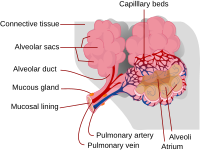
Photo from wikipedia
Flow-controlled ventilation (FCV) is characterized by a constant flow to generate active inspiration and expiration. While the benefit of FCV on gas exchange has been demonstrated in preclinical and clinical… Click to show full abstract
Flow-controlled ventilation (FCV) is characterized by a constant flow to generate active inspiration and expiration. While the benefit of FCV on gas exchange has been demonstrated in preclinical and clinical studies with adults, the value of this modality for a pediatric population remains unknown. Thus, we aimed at observing the effects of FCV as compared to pressure-regulated volume control (PRVC) ventilation on lung mechanics, gas exchange and lung aeration before and after surfactant depletion in a pediatric model. Ten anesthetized piglets (10.4 ± 0.2 kg) were randomly assigned to start 1-h ventilation with FCV or PRVC before switching the ventilation modes for another hour. This sequence was repeated after inducing lung injury by bronchoalveolar lavage and injurious ventilation. The primary outcome was respiratory tissue elastance. Secondary outcomes included oxygenation index (PaO2/FiO2), PaCO2, intrapulmonary shunt (Qs/Qt), airway resistance, respiratory tissue damping, end-expiratory lung volume, lung clearance index and lung aeration by chest electrical impedance tomography. Measurements were performed at the end of each protocol stage. Ventilation modality had no effect on any respiratory mechanical parameter. Adequate gas exchange was provided by FCV, similar to PRVC, with sufficient CO2 elimination both in healthy and surfactant-depleted lungs (39.46 ± 7.2 mmHg and 46.2 ± 11.4 mmHg for FCV; 36.0 ± 4.1 and 39.5 ± 4.9 mmHg, for PRVC, respectively). Somewhat lower PaO2/FiO2 and higher Qs/Qt were observed in healthy and surfactant depleted lungs during FCV compared to PRVC (p < 0.05, for all). Compared to PRVC, lung aeration was significantly elevated, particularly in the ventral dependent zones during FCV (p < 0.05), but this difference was not evidenced in injured lungs. Somewhat lower oxygenation and higher shunt ratio was observed during FCV, nevertheless lung aeration improved and adequate gas exchange was ensured. Therefore, in the absence of major differences in respiratory mechanics and lung volumes, FCV may be considered as an alternative in ventilation therapy of pediatric patients with healthy and injured lungs.
Journal Title: Frontiers in Pediatrics
Year Published: 2022
Link to full text (if available)
Share on Social Media: Sign Up to like & get
recommendations!